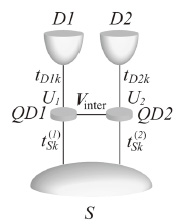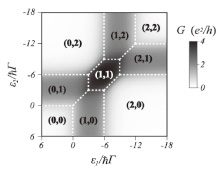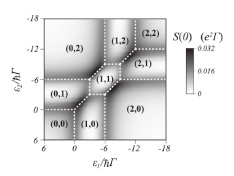@
Optical Science Laboratory
@The various kinds of Kondo effect not seen in conventional metallic systems
have been revealed in semiconductor quantum dot (QD) systems since the
many parameters are experimentally tunable [1]. In a double quantum dot
(DQD), the pseudospin state is represented as a state with an electron
in either of two capacitively coupled QDs. We have theoretically investigated
the pseudospin Kondo effect without spin degree of freedom [2].
@In this work, we consider the spin degree of freedom and study the spin/pseudospin
Kondo effects in a laterally coupled DQD as shown in Fig. 1. at zero temperature
using the slave-boson mean-field theory based on the nonequilibrium Greenfs
function method. The notation (N1,N2) in Figs. 2 and 3 indicates the number of electrons in two QDs. Figure 2 shows the linear conductance on the charge stability diagram. In the pseudospin Kondo regime such as the boundary between (1,0) and (0,1), we cannot observe the characteristic property. Thus, it is difficult to capture the signature of the pseudospin Kondo effect by standard transport measurements. In contrast, we plot the zero-frequency current shot noise on the charge stability diagram under low bias voltage condition (eVSD/Ε‘=0.1, where ‘ is the coupling strength between the reservoir and the QD) in Fig. 3. In contrast to the linear conductance, the current shot noise can provide a clear signature of the pseudospin Kondo effect, namely the current shot noise is maximal in the psuedospin Kondo regime [3]. So far we consider the DQD without coherent indirect coupling [4], in the following, we examine effects of the coherent indirect coupling on the spin Kondo effect. When each QD holds just one electron, the fourth-order perturbation theory of the tunneling process between the reservoir and QDs gives rise to the antiferromagnetic kinetic exchange coupling. Although the effect of coherent indirect coupling had been discussed only on the orbital degree of freedom, we clarified this antiferromagnetic exchange coupling on the spin degree of freedom for the first time. Consequently we found that the spin Kondo effect in (1,1) region is suppressed by such an antiferromagnetic exchange coupling.
@This research was supported by ICORP of Japan Science and Technology Agency, FIRST of Government of Japan, and KAKENHI.
[1] S. Sasaki et al., Nature 405 (2000) 764.
[2] T. Kubo et al., Phys. Rev. B 77 (2008) 041305(R).
[3] T. Kubo et al., Phys. Rev. B 83 (2011) 115310.
[4] T. Kubo et al., Phys. Rev. B 74 (2006) 205310.
@
 |
 |
 |
||||||||
|
|
|